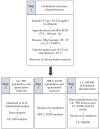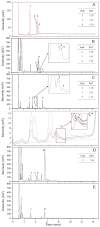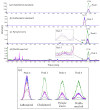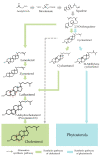Presence of Cholesterol in Non-Animal Organisms: Identification and Quantification of Cholesterol in Crude Seed Oil from Perilla frutescens and Dehydrated Pyropia tenera
- PMID: 34205624
- PMCID: PMC8234223
- DOI: 10.3390/molecules26123767
Presence of Cholesterol in Non-Animal Organisms: Identification and Quantification of Cholesterol in Crude Seed Oil from Perilla frutescens and Dehydrated Pyropia tenera
Abstract
Studies have reported that cholesterol, a molecule found mainly in animals, is also present in some plants and algae. This study aimed to determine whether cholesterol exists in three dehydrated algae species, namely, Pyropia tenera, Saccharina japonica, and Undaria pinnatifida, and in one plant species, namely, Perilla frutescens (four perilla seed oil samples were analyzed). These species were chosen for investigation because they are common ingredients in East Asian cuisine. Gas chromatography-flame ionization detection (GC-FID) analysis found that cholesterol was present in P. tenera (14.6 mg/100 g) and in all four perilla seed oil samples (0.3-0.5 mg/100 g). High-performance liquid chromatography with evaporative light-scattering detection (HPLC-ELSD) also demonstrated that cholesterol was present in P. tenera (14.2 mg/100 g) and allowed the separation of cholesterol from its isomer lathosterol. However, cholesterol could not be detected by HPLC-ELSD in the perilla seed oil samples, most likely because it is only present in trace amounts. Moreover, liquid chromatography-tandem mass spectrometry (LC-MS/MS) confirmed the presence of cholesterol in both P. tenera and perilla seed oil. MRM results further suggested that lathosterol (a precursor of cholesterol) was present in P. tenera.
Keywords: GC-FID; HPLC-ELSD; LC-MS/MS; algae; cholesterol; lathosterol; perilla seed oil.
Conflict of interest statement
The authors declare no conflict of interest. The funders had no role in the design of the study; in the collection, analyses, or interpretation of data; in the writing of the manuscript; or in the decision to publish the results.
Figures





References
-
- Andrade L.D.O. Understanding the role of cholesterol in cellular biomechanics and regulation of vesicular trafficking: The power of imaging. Biomed. Spectrosc. Imaging. 2016;5:S101–S117. doi: 10.3233/BSI-160157. - DOI
MeSH terms
Substances
LinkOut - more resources
Full Text Sources
Miscellaneous

